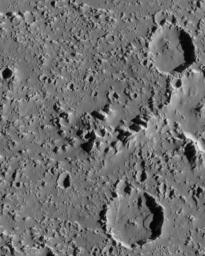Landslides on Callisto
Caption:
Recent Galileo images of the surface of Jupiter's moon Callisto have revealed large landslide deposits within two large impact craters seen in the right side of this image. The two landslides are about 3 to 3.5 kilometers (1.8 to 2.1 miles) in length. They occurred when material from the crater wall failed under the influence of gravity, perhaps aided by seismic disturbances from nearby impacts. These deposits are interesting because they traveled several kilometers from the crater wall in the absence of an atmosphere or other fluids which might have lubricated the flow. This could indicate that the surface material on Callisto is very fine-grained, and perhaps is being "fluffed" by electrostatic forces which allowed the landslide debris to flow extended distances in the absence of an atmosphere.
This image was acquired on September 16th, 1997 by the Solid State Imaging (CCD) system on NASA's Galileo spacecraft, during the spacecraft's tenth orbit around Jupiter. North is to the top of the image, with the sun illuminating the scene from the right. The center of this image is located near 25.3 degrees north latitude, 141.3 degrees west longitude. The image, which is 55 kilometers (33 miles) by 44 kilometers (26 miles) across, was acquired at a resolution of 100 meters per picture element.
Background Info:
The Jet Propulsion Laboratory, Pasadena, CA manages the Galileo mission for NASA's Office of Space Science, Washington, DC. JPL is an operating division of California Institute of Technology (Caltech).
This image and other images and data received from Galileo are posted on the World Wide Web, on the Galileo mission home page at URL http://galileo.jpl.nasa.gov.
Cataloging Keywords:
| Name |
Value |
Additional Values |
| Target |
Callisto |
Jupiter |
| System |
Jupiter |
|
| Target Type |
Satellite |
Planet |
| Mission |
Galileo |
|
| Instrument Host |
Galileo Orbiter |
|
| Host Type |
Orbiter |
|
| Instrument |
Solid-State Imaging (SSI) |
|
| Detector |
|
|
| Extra Keywords |
Atmosphere, Crater, Grayscale, Impact |
| Acquisition Date |
|
| Release Date |
1997-12-10 |
| Date in Caption |
|
|
| Image Credit |
NASA/JPL/ASU |
| Source |
photojournal.jpl.nasa.gov/catalog/PIA01095 |
| Identifier |
PIA01095 |

 Planetary Data System
Planetary Data System
